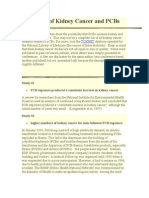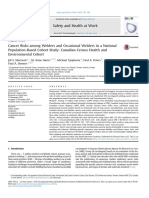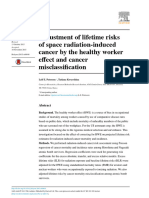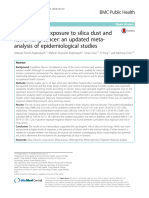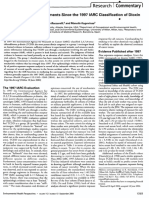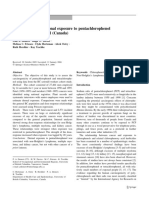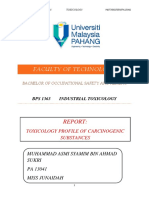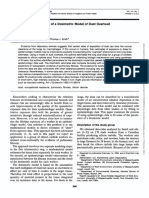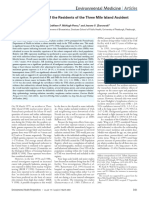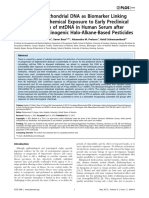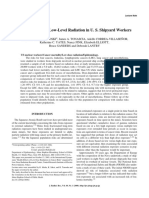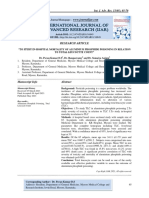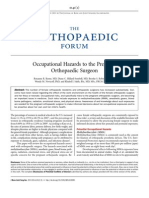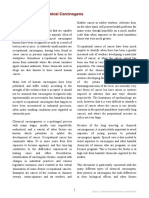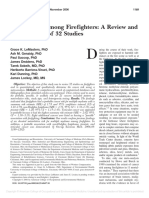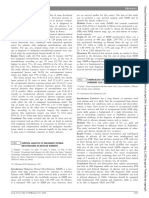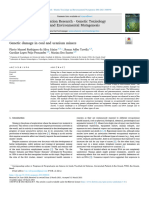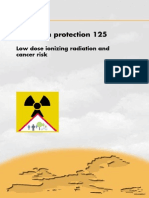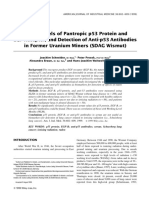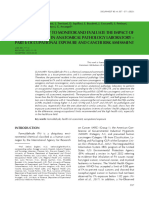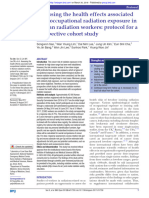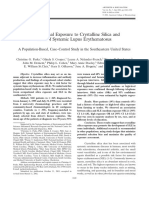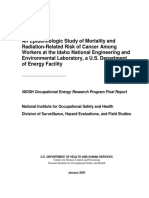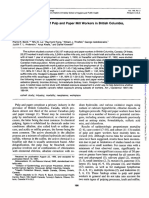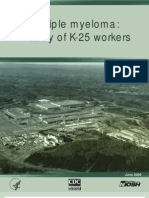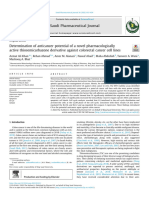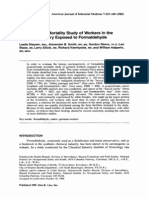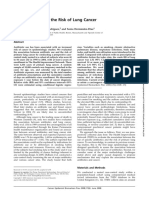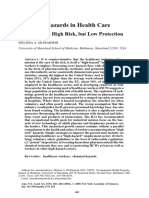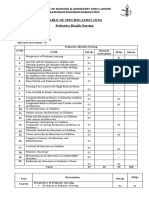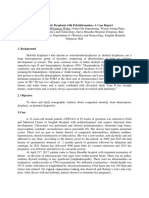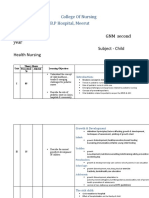10 risques
10 risques
Uploaded by
DjoCopyright:
Available Formats
10 risques
10 risques
Uploaded by
DjoCopyright
Available Formats
Share this document
Did you find this document useful?
Is this content inappropriate?
Copyright:
Available Formats
10 risques
10 risques
Uploaded by
DjoCopyright:
Available Formats
Applied Occupational and Environmental Hygiene
ISSN: 1047-322X (Print) 1521-0898 (Online) Journal homepage: https://www.tandfonline.com/loi/uaoh20
Cancer and Reproductive Risks Among Chemists
and Laboratory Workers: A Review
John M. Dement & John R. Cromer
To cite this article: John M. Dement & John R. Cromer (1992) Cancer and Reproductive Risks
Among Chemists and Laboratory Workers: A Review, Applied Occupational and Environmental
Hygiene, 7:2, 120-126, DOI: 10.1080/1047322X.1992.10388032
To link to this article: https://doi.org/10.1080/1047322X.1992.10388032
Published online: 24 Feb 2011.
Submit your article to this journal
Article views: 34
Citing articles: 10 View citing articles
Full Terms & Conditions of access and use can be found at
https://www.tandfonline.com/action/journalInformation?journalCode=uoeh20
Cancer and Reproductive Risks Among
Chemists and Laboratory Workers: A Review
John M. DementA and John R. CromerB
ANational Institute of Environmental Health Sciences, Research Triangle Park, North Carolina 27709; BDuke
University Medical Center, Durham, North Carolina 27706
The Occupational Safety and Health Administration estimates sures may change frequently.
that approximately one million persons work in 74,000 United Laboratory workers may be exposed through all of the
States laboratories. Personnel who work in biomedical and chem- typical routes (inhalation, dermal absorption, injection, and
ical laboratories have potential exposures to numerous occupa- ingestion). Although relatively little exposure monitoring
tional hazards. Available epidemiologic data suggest that chem-
data have been published for laboratory workers, expo-
ists and other laboratory workers are at increased mortality risk
for certain cancers such as malignant lymphoma, leukemia, and
sures t o vapors from organic solvents (e.g., benzene, tol-
cancers of the gastrointestinal tract. In addition, data suggest an uene, xylene, ethers, dioxane, carbon disulfide, etc.) and
association between laboratory work and adverse pregnancy out- mercury often represent the m o s t significant inhalation
come. Occupational health surveillance of laboratory workers hazard. Use of these materials also represents potential for
requires a comprehensive approach, addressing all major organ dermal absorption. A less well-recognized potential for
systems, due to mixed exposures experienced by laboratory work- exposure is surface contamination by nonvolatile com-
ers and the constantly changing work environment. Control strat- pound~.c5-~) Needle pricks and puncture wounds from
egies for laboratory exposures must rely heavily on the use of broken labware are common sources of exposure by in-
engineering controls such as local exhaust ventilation, good work jection. In addition to laboratory workers, maintenance and
practices, and appropriate personal protective equipment. De- service personnel who enter laboratories are potentially
ment, J.M.; Cromer, J.R.: Cancer and ReproductiveRisks Among Chem-
exposed to hazardous materials. Fume hood and duct
ists and Laboratory Workers: A Review. Appl. Occup. Environ. Hyg.
7(2):120-126; 1992.
maintenance and repair are noteworthy sources of dermal
exposures for maintenance personnel.
The wide variety of hazards and potential exposures in
Introduction biomedical research laboratories requires an occupational
health surveillance program that is both comprehensive
Workers in biomedical and chemical laboratories have and flexible. This article reviews published epidemiolog-
potential exposures to numerous occupational hazards.' 1-3) ical data for laboratory workers relative to cancer risks and
Among these hazards are exposures to chemicals, radio- risks of adverse pregnancy outcome with an emphasis on
active materials, and biological agents as well as safety chemical exposures. Occupational health surveillance
hazards such as fire, explosion, and electrical shock. Lab- principles and their application to laboratory worker pop-
oratories pose a significant challenge to occupational health ulations are discussed.
specialists due to the nature of the work conducted and
special characteristics of the work environment. Review of Epidemiologic Data
The number of hazardous materials used or stored in
Mortality and Cancer Incidence Studies
research laboratories is far greater than would be found
in typical factory or nonlaboratory work environments, Characteristics and general findings of mortality and can-
although the quantities of each material are usually limited. cer incidence studies among laboratory workers and
While many chemicals that are used in laboratories have chemists are summarized ii Table I. For this review, two-
known toxic properties and occupational exposure limits, sided confidence intervals for proportionate mortality ra-
the nature of research requires handling of chemicals whose tios (PMRs) and standardized mortality ratios (SMRs) were
toxic properties are largely unknown.(4)Additionally, lab- calculated assuming a Poisson distribution if no confidence
oratory procedures are often nonroutine requiring devel- interval was given in the original reference. Of the eight
opment of safety precautions on an ad hoc basis. Lastly, studies listed, three are proportionate mortality studies and
research projects and thus chemicals and potential expo- three are cohort studies using the SMR as the outcome
120 APPL. OCCUP. ENVIRON. HYG. 712) . FEBRUARY 1992
measure. yses by detailed occupational groups, duration of employ-
Li et aZ.(9)conducted a proportionate mortality study of ment, o r latency.
American Chemical Society (ACS) members. Their study Olin(l*)studied mortality among 530 male chemistry
included 3637 ACS members who died between 1948 and graduates (1930-1950) from the Royal Institute o f Tech-
1967.A total of 2152 individuals were identified as chemists nology in Sweden with follow-up through 1974. When
based on occupational information contained on death compared t o the general male population of Sweden, 22
certificates. Among male chemists 20-64 years of age, a cancer deaths were observed while 13were expected (SMR
PMR of 1.25 (95% confidence interval [C.I.] 1.1-1.3) was = 169,95% C.I. 129-769). Excess mortality was observed
observed for all cancers. Increased cancer mortality was due to lymphomas and leukemia (SMR = 353, 95% C.I.
also observed for male chemists older than 64 years. Can- 129-769). Slight excess mortality was observed for cancers
cer of the pancreas was elevated in both age groups (PMR of the urinary organs (3 observed versus 1 expected). A
= 1.6,95%C.I. 1.2-2.1). For lymphatic and hematopoietic crude analysis of occupations suggested that work as an
cancer, a PMR of 1.7 (95% C.I. 1.4-2.0) was observed. organic chemist was most strongly associated with excess
Among the small female cohort, a PMK of 2.1 (95% C.I. leukemia/lymphoma cancer mortality. N o analyses by du-
0.9-2.8) was observed for breast cancer, and suicide deaths ration of work as a chemist or latency were reported.
were five times expected. These same general patterns for Additionally, the method used to classify “chemists” versus
mortality were observed by Walrath et al.(’O) in a larger “nonchemist” would likely result in significant misclassi-
study of female ACS members who died between 1925 and fication and, thus, reduced risk estimates.
1979. This latter study also observed excesses o f stomach Searle et ~ l . ( published
’~) a short report based on their
cancer (PMR = 1.9, 95% C.I. 0.9-4.51, breast cancer (PMK analysis of 1332 death certificates for members o f the Koval
= 1.6, 95% C.I. 1.1-2.9), and ovarian cancer (PMR = 2.2, Institute of Chemistry who died between 1965 and 1975.
95% C.I. 1.1-4.2). Neither of these studies included anal- Elevated PMRs were observed for all cancers and cancers
TABLE I. Summary of Mortalitv and Cancer Incidence Studies of Laboratorv Workers and Chemists
Study Description of Cohort Study Number Reference Latency
Authors and Date Type Population Studied Size Period Cases Population Analyses Study Findings and Conclusions
Li, F.P.; et al. PMR American Chemical - 1948-1967 3637 U.S. No Males
(1969) Society members Professional All cancers 694 obs 1572 exp
Males Lymph /hema 127 obs 176 exp
1950 Pancreas 56 obs 135 exp
Females
Breast cancer 15 obs 17 exp
Suicide 5 times exDected
O h , G.R. SMR Chemical engineering 530 1930-1974 58 Sweden No All deaths 58 obs./67 exp.
(1976) graduates, males All cancers 22 obs./l3 exp.
1930-1950 Lymph./hema. 6 obs.il.7 exp.
Urinary 3 obs.il.0 exo.
Searle, C.E.; et al PMR Royal Institute of - 1965-1975 1332 Britain No Elevated PMR for all cancers,
(1978) (Abstract) Chemistry members -.
lymphomas, and colon/rectum
Olin, G.R.; Ahlbom, A. SRM Royal Institute of 822 1930-1 977 83 Sweden No All deaths 83 obs./l03 8 exp.
(1980) Technology graduates All cancers 32 obs./24.2 exp.
1930-1959 Lymph /hema. 7 obs./3.2 exp.
-
Brain 5 obs./l.2 exp.
Hoar, S.K.; Pell, S. SMR DuPont chemists, 3761 1964-1977 204 US No Males
(1981) chemical engineers All deaths 198 obs./418.3 exp.
All cancers 43 obs./86 exp.
Large Int 12 obs./6.9 exp.
Leukemia 4 obs./3.4 exp.
.~ -.
Walrath, J.; et al. PMR American Chemical - 1925-1979 347 US. No All cancers 111 obsi73.7 exp.
(1985) Society members Stomach 5 obs.iZ.8 exp.
Pancreas 5 obs./2.8 exp
Lymph./hema. 13 obs./5.9 exp.
Breast 30 obs./5.8 exp.
Ovary 13 obs./5.8 exp.
Suicides 36 obs./6.7 exo.
Maher, K V , SMR Rohm and Hass 1510 1950-1978 95 us Yes All deaths 95 obs 1173 2 exp
Oefanso, B S researchers white All cancers 21 obs 131 8 exp
(1986) 1950-1 959 males Lymph /hema 5 obs 14 2 exp
Digestive 9 obs 17 7 exp
’PMR = proportionate mortality ratio SMR = standardized mortality ratio
APPL. OCCUP. €NV/RUN. HYG. 7(2) . FEBRUARY 1992 121
of the colon and rectum. This report is merely an abstract TABLE II. All Cancer Mortality Among Laboratory Workers
with few details as to observed and expected deaths or Author Study Risk
detailed methods of analysis. and Date Type Observed Expected Ratio 95% C.I.6
Olin and Ahlbom,('3) in a follow-up of their 1976 report, Li, et al. PMR 694 572 1.2 1.1-1.3
studied mortality among a Swedish cohort of 822 male (1969)
chemists who graduated during 1930-1959 and were fol- Olin SMR 22 13 1.7 1.1-2.6
lowed through 1977. Expected deaths were calculated using (1976)
rates from the general male population of Sweden and Olin and Ahlbom SMR 32 24.2 1.3 0.9-1.8
using rates from a similar cohort of male architects grad- (1980)
uating from the same school. An SMR of 132 (95% C.I. 90- Hoar and Pel1 SMR 43 86.OC 0.5 0.4-6.6
186) was observed for cancer mortality among chemists (1981)
as contrasted to a cancer SMR of 54 (95% C.I. 27-97) for Walrath, et al. PMR 111 73.7 1.5 1.1-2.0
(1985)
architects using general male population death rates.
Maher, et at. SMR 21 31.8 0.7 0.4-1.1
Chemists were found to experience significant excess mor- (1986)
tality due to lymphatic and hematopoietic cancers (SMR
APMR = proportionate mortality ratio; SMR = standardized mortality ratio.
= 219, 95% C.I. 87-451) and brain cancers (SMR = 417, EC.I. = confidence interval based on Poisson distribution.
95% C.I. 135-974). N o analyses by specific occupation or CExoected based on U S. rates.
cancer latency were provided.
Cancer mortality and cancer incidence among chemists
employed by a large U S . chemical producer were studied TABLE 111. Respiratory System Cancer Among Laboratory Workers"
by Hoar and Pell.(**)This cohort consisted of 3686 white
Author Study Risk
male and 75 white female chemists employed in 1959 and and Date TypeB Observed Expected Ratio 95% C.LC
followed through 1977. For calculation of standardized
Li, et al. PMR 109 108 1.0 0.8-1.2
incidence ratios (SIR), the experience of 19,262 male and (1969)
673 female nonchemists of the same company employed Olin SMR 1 2.4 - -
in 1959 was used. Chemists experienced lower overall (1976)
mortality (SMR = 82, 95% C.I. 71-94) and significant def- Olin and Ahlbom SMR 3 4.0 - -
icits of mortality due to cancer of the lung (SMR = 41, (1980)
95% C.I. 20-75) and arteriosclerotic heart disease (SMR Hoor and Pel1 SMR 9 30.7 0.3O 0.1-0.6
= 73, 95% C.I. 57-91) using rates for the United States. (1981)
Excess mortality was observed for colon cancer among Walrath, et al. PMR 5 5.7 0.9 0.3-2.1
males (SMR = 178, 95% C.I. 97-305). Cancer incidence (1985)
analyses for males indicated increased risk for malignant Maher, et al. SMR 3 10.9 0.3 0.1-0.9
I1986)
melanoma (SIR = 239, 95% (2.1. 111-454) and prostate
cancer (SIR = 124, 95% C.I. 54-246) compared to data AICDA 8th Revision Codes 160-163
BPMR = proportionate mortality ratio, SMR = standardized mortality ratio
from the Third National Cancer Survey. An important lim- C C I = confidence interval based on Poisson distribution
itation of this study lies with classification as a chemist as OExpected based on U S rates. only lung cancer (ICDA 162) was reported
only the classification in 1959 was used with no further
consideration of an individual's work history. Additionally,
n o analyses by latency were undertaken. Supportive evi- TABLE IV. Lymphatic and Hematopoietic System Cancer Mortality
dence for an association between malignant melanoma and Among Laboratory Workers"
employment as chemists has been obtained from a case- Author Study Risk
control study among workers at the Lawrence Livermore and Date Type' Observed Expected Ratio 95% C.1.C
National Lab~ratory.('~) Li, et al. PMR 127 76 1.7 1.4-2.0
Mortality among 1510 white male chemical researchers (1969)
was reported by Maher and Defonso.(16)The cohort was Olin SMR 6 1.7O 3.5 1.3-7.6
defined using detailed work history information from per- (1976)
sonnel records of a large chemical producer and included Olin and Ahlbom SMR 7 3.2 2.2 1.2-4.5
1510 white males employed more than 2 weeks in the (1980)
research division between January 1, 1950 and December Hoar and Pel1 SMR 9 9.v 1.0 0.5-1.8
(1981)
31, 1959. This cohort was followed through December 31,
Walrath, et al. PMR 13 5.9 2.2 1.2-3.8
1978. Expected deaths were calculated using rates for U S . (1985)
white males. This cohort demonstrated a strong healthy Maher, et al. SMR 5 4.2 1.2 0.4-2.8
worker effect with an all cause SMR of 55 (95% C.I. 44- (1986)
67). Deficits were observed for overall cancer mortality AICDA 8th Derision Codes 200-209
(SMR = 66, 95% C.I. 41-101) with a large deficit for res- BPMR= proportionate mortality ratio, SMR = standardized mortalily ratio
cC I = conlidence interval based on Poisson distribution
piratory system cancer (SMR = 28, 95% C.I. 6-80). Ex- Dlncludes ICDA Codes 200-207 only
cesses were observed for stomach cancer (SMR = 293, 'Expected based on U S rates
122 APPL. OCCUP.ENVIRON. HYG. 712) . FEBRUARY 1992
TABLE V. Digestive System Cancer Mortality Among and hematopoietic cancer mortality which has emerged.
Laboratory WorkersA
Studies of Reproductive Outcome
Author Study Risk
and Date TvoeB Observed Exoected Ratio 95% C.LC Due to the relative proportion of reproductive age, fe-
LI, et a1 PMR 237 211 11 10-13 males employed in research laboratories, and potential
(1969) exposures to reproductive toxins, considerable attention
Ol1n SMR 6 45 13 05-28 has been focused on potential effects of laboratory em-
(1976) ployment on reproductive outcome. These studies are
Olin and Ahlbom SMR 8 92 09 04-17 summarized in Table VI. Most studies have generally been
(1980) cross-sectional or case-control in design.
Hoar and Pel1 SMR 19 13 2 14 08-22 Spontaneous abortions among 56 women employed in
(1981)
a hospital laboratory were studied by Strandberg et ~ 1 . 1 ~ ’ )
Walrath, et al PMR 29 20 5 14 09-20
(1985)
Among these workers, 71 pregnancies had occurred. Of
Maher, et a1 SMR 9 77 12 05-22
those exposed to laboratory work, 8/24 resulted in spon-
(1986) taneous abortion versus 9/47 not exposed resulting in a
W D A 8th Revision Codes 150-159
crude risk ratio of 1.7. Potential confounding with other
BPMR = proportionate mortality ratio SMR = standardized mortality ratio variables such as smoking prevented definitive interpre-
cC I = conlidence interval based on Poisson distribution tation of these results.
Infants with congenital malformations born to females
employed in university laboratories have been studied.(l8)
95% C.I. 80-751), prostate cancer (SMR = 240, 95% C.I. The study group included 727 women employed in lab-
89-868), and cancers of the hematopoietic system (SMR oratories at Uppsala University during 1972-1977. A total
= 119, 95% C.I. 39-553) although these excesses were of 245 births were recorded among those directly involved
not statistically significant. Limited analysis by latency and with laboratory work. Laboratory workers delivered 29
duration and laboratory work failed to demonstrate sig- infants with congenital malformations versus 17 expected
nificant trends in cancer mortality; however, the longest based on rates from the Swedish Register of Congenital
laboratory work duration was only more than 5 years. Malformations. A significant increase in serious malfor-
Each of the studies reviewed above has limitations that mations was observed including intestinal atresia. A sub-
make causal interpretation difficult. Limitations of PMR sequent case-control study by Ericson et ~ 1 . ( ~of 9 ) 200
studies are well documented and include the inability to gastrointestinal atresia cases demonstrated an association
estimate the overall mortality risk in the study population. with laboratory work.
This limitation may result in biased cause specific risk Pregnancy outcome of women working in pharmaceu-
estimates if the population’s overall mortality is substan- tical industry laboratories was studied by Hansson et
tially different from the reference population. In addition A total 1470 women and 1161 births were studied. The
to PMR study limitations, studies of cancer mortality among miscarriage rate for women employed in chemical labo-
laboratory workers and chemists suffer from lack of anal- ratories was 18 percent compared with a rate of 10 percent
yses by work history; thus, most cohorts are diluted with among the nonchemical group. Significant increases in
individuals who may have experienced little if any labo- neonatal deaths and major malformations were observed
ratory work. Additionally, most studies lack detailed anal- among chemical laboratory workers.
yses by time since first employed (latency) or duration of The Swedish Medical Register of Births and census data
laboratory work. were used by Ericson et ~ 1 . ( ~to* identify
) 1161 births to
Although results of the studies reviewed above are mixed, women coded as laboratory workers. Deliveries to labo-
some general trends emerge. Tables 11-V summarize over- ratory workers resulted in 1.55 percent perinatal deaths
all cancer mortality and morality due to cancers of the versus 1.04percent for all births. Significant malformations
respiratory, digestive, and lymphatidhematopoietic sys- were observed in 2.41 percent of births to laboratory work-
tems for the six studies providing sufficient details. In these ers versus 1.64 percent for all births. A nested case-control
tables, risk ratios are calculated only for those studies and study did not demonstrate any specific type of laboratory
cancer sites with five or more observed or expected deaths. work or exposure more common among cases than controls.
All cancer mortality was significantly elevated in three of The relationship between solvent exposures in labora-
six studies, and all studies found deficits or expected lung tories and pregnancy outcome has been studied by Axels-
cancer mortality. Four of six studies demonstrated signif- son e? u L . ( ~ ~The
) study population included 782 women
icantly increased mortality due to cancers of the lymphatic born after 1935 and working in laboratories at the Uni-
and hematopoietic systems. Risk ratios for digestive system versity of Gothenburg between 1968 and 1979. Information
cancers were greater than 1.0 for five of six studies, al- concerning 1160 pregnancies and exposure to solvents was
though none of these values were statistically significant obtained by questionnaire and information on congenital
at the 95 percent level. Anecdotal data suggest that historic malformations was obtained from the Swedish Register of
use of organic solvents such as benzene in research lab- Congenital Malformations. A slight increase in the relative
oratories could partially explain the pattern of lymphatic risk (RR) of miscarriage (RR = 1.31, 95% C.I. 0.89-1.91)
APPL. OCCUP. ENVIRON. HYG. 7/2/ . FEBRUARY 1992 123
TABLE VI. Summarv of Reoroductlve Outcome Studies of Laboratow Workers
~ ~
Study Description of Number of Number of
Authors and Date Type Population Studled Females Pregnancies Study Findings and Conclusions
Strandberg, M.; et al. Cross- Hospital lab workers 56 71 8/24 pregnancies of lab workers were abortions vs. 9/47 for nonlab
f 1978) sectional workers.
~
Meirik, 0 , el al Follow-up University lab workers 727 245 Significant increase in serious malformations (intestinal atresia)
(1979)
Ericson, A.; et al. Case- Gastrointestinal atresia - 200 7 cases of gastrointestinal atresia versus 2.5 expected in lab workers.
(1982) control cases
~ ~ _ _ ~ _
Hansson, E.; et al. Cross- Pharmaceutical lab workers 110 78 18% miscarriage rate for lab workers vs. 10% for all others.
(1980) sectional Increased rate of congenital malformations.
Ericson, H.; et al. Record Record linkage with - 1161 Increase in perinatal deaths and major malformations, No specific
(1984) linkage Swedish Medical Birth type of lab work implicated.
Registry
Axelsson, G.; et al. Follow-up Women engaged in lab 745 556 No increase in miscarriage or malformation rates.
(1984) 1968-1 979
Heidam, L.Z. Follow-up Women employed >1 3362 1972 No significant increase in spontaneous abortions.
(1984) month in selected
occupations 1972-1980
Lindbohm, M.; et at. Registry Hospital abortions during - 1752 Lab assistants demonstrated a significantly increased risk of
(1984) 1973-1 976 spontaneous abortion (RR = 1.26).
McDonald, A.D.; et al. Cross- Hospital deliveries 50,067 104,649 No significant increases in spontaneous abortions, congenital
(1987) and sectional 1982-1984 malformations, stillbirths, or low birth weight in medical lab
McDonald, J.C.; et al. and assistants. Aromatic hydrocarbon exposures associated with
(1987) Case- malformations.
control
Axelsson, G.; Follow-up Petrochemical lab workers, 110 130 10 miscarriages among lab workers vs. 6.3 expected but not
Rylander, R. 1973-1 987 statistically significant. One lab reported a significant number of
(1989) miscarriages (3 observed vs. 0.7 expected).
was observed for those who reported working with sol- hospitals during 1982-1984. A total of 104,649pregnancies
vents. N o differences in perinatal death rates were observed. were included. Each woman was interviewed in detail in
Heidam(23)studied spontaneous abortions among lab- order to ascertain occupational, social, and personal char-
oratory workers in Denmark. Employer and trade union acteristics. Outcomes of interest included spontaneous
records were used to identify 982 women 18-40 years of abortions, stillbirths,congenital defects,and low birth weight.
age in 1980 and employed in laboratories a minimum of Among the 503 pregnancies recorded to medical labora-
one month during 1972-1980. Spontaneous abortion rates tory technicians, no increases in any of these outcome
were compared with 842 pregnancies in nonlaboratory parameters were observed. However, further case-control
workers. The odds ratio for spontaneous abortion was analyses of 301 births with congenital malformations drawn
found to be 1.1 (95% C.I. 0.5-2.3) for industry laboratory from the larger study population demonstrated a statisti-
workers and 0.8 (95% C.I. 0.3-1.6) for workers in univer- cally significant association between aromatic solvent ex-
sity laboratories. posures and urinary tract malformations (RR = 2.3). Tol-
The relationship between parental occupational expo- uene exposures appeared most strongly associated. These
sures and spontaneous abortions in Finland has been stud- latter findings are of significance to general laboratory
ied by Lindbohm et Computerized hospital discharge work that often involves considerable use of solvents in-
data from the Finnish National Board of Health was used cluding toluene.
to identify spontaneous abortions between 1973 and 1976. Axelsson and RylandercZ7)reported results of a study of
Occupations of both parents, number of children, and birth pregnancy outcome and employment in petrochemical plant
data were obtained from census data. The study included laboratories. The study included 110 women employed at
1752 pregnancies among women identified as laboratory least one month between January 1973 and January 1987.
assistants. An odds ratio of 1.26 (95% C.I. 1.06-1.49) for Information on pregnancy outcome and exposure during
spontaneous abortion was found for the laboratory group pregnancy was collected by questionnaire (95% response
using rates for all women in the study to calculate expected rate). Information on birth weight, length of gestation,
values. Apgar score, and number of previous pregnancies was
A large study of occupation and pregnancy outcome in obtained through linkage with the Swedish Medical Birth
Canada has been reported by McDonald et uf.(25,26) The Registry. A total of 130 pregnancies were reported with
study cohort consisted of 50,067 women who delivered or work in laboratories reported for 55 pregnancies.For women
were treated for spontaneous abortions in 11 Montreal who reported working in laboratories during the first
124 APPL. OCCUP. ENVIRON. HYG. 7(2) . FEBRUARY 1992
trimester, 10 miscarriages were reported versus 6.3 ex- routine clinical parameter screening.
pected based on miscarriage rates for the area in which In contrast to medical screening, epidemiologic sur-
the plant was located. This difference was not statistically veillance involves analysis of data to detect trends in dis-
significant. One laboratory reported an elevated number ease incidence or to identify case clusters in an effort to
of miscarriages (3 versus 0.7 expected); however, a specific detect unexpected consequences of exposure or to ensure
occupational factor was not identified. N o association be- that known effects do not occur. Therefore, epidemiologic
tween laboratory work and birth weight was observed. surveillance can be used to generate hypotheses concern-
In summary, available studies reviewed above suggest ing diseases in populations and their possible occupational
an association between laboratory work and adverse preg- etiology. Halperin et al.(3l)point out that medical screen-
nancy outcome, although a causal relationship cannot con- ing programs can be used to assess the adequacy of more
clusively be demonstrated. In all studies, information on primary prevention programs (e.g., engineering controls,
exposure is imprecise and exposure timing relative to protective equipment, etc.) designed to reduce or elimi-
pregnancy is largely unknown. In addition, most studies nate exposures. Hence, statistical analyses of clinical sur-
have been cross-sectional in design and have relied heavily veillance information for suspected target organ systems,
on existing records and questionnaire information; thus, taken in connection with industrial hygiene data, are useful
the possibility of selection and recall biases cannot be in identifying clusters of clinical changes indicative of con-
overlooked. However, an association between adverse re- ditions requiring improved primary preventive measures.
productive outcome and laboratory work must be consid- For example, occupational benzene exposures have been
ered biologically plausible given potential exposures in associated with reversible changes in clinical blood pa-
the laboratory to numerous substances considered tera- rameters; thus, analysis of surveillance data can provide
togens or reproductive toxins.(28)Additional supportive information useful in identifying populations with exces-
data come from one study that demonstrated significantly sive exposures. Once these exposures are identified, ap-
increased frequencies of chromosome aberrations and sister- propriate control strategies can be developed. By reducing
chromatic exchange among laboratory workers and their exposures, the risk of developing cancer is likewise reduced.
offspring compared to controls.(29)However, a similar study Application of epidemiologic principles and methods to
of blood lymphocytes from 59 laboratory workers exposed prospectively collected medical screening and disease data
to solvents failed to demonstrate statistically increased fre- provides a valuable surveillance tool, especially when com-
quencies of sister-chromatic exchanges or micronuclei bined with appropriately recorded work history and oc-
compared to office workers.(3") cupational exposure information. The possibility that lab-
oratory work is associated with adverse effects o n
reproduction deserves special attention in designing med-
Discussion and Conclusions ical surveillance programs. Emphasis should be placed on
Available epidemiologic data for laboratory workers sug- questionnaires that record reproductive events and risk
gest that some populations may be at increased risk for factors in a prospective manner.
selected cancers such as lymphomas, leukemia, and can- Medical screening and epidemiologic surveillance are
cers of the gastrointestinal system. An association between part of the continuum of measures directed toward oc-
laboratory work and adverse pregnancy outcome is sug- cupational disease prevention. Primary prevention in-
gested by available information. However, specific expo- volves procedures and precautions largely directed at elim-
sures responsible for these health effects have not been inating o r reducing occupational exposures (e.g., material
adequately identified due to inadequate exposure infor- substitution, engineering control measures, work prac-
mation and the extremely varied nature of the laboratory tices, use of protective equipment). The nature of labo-
environment. Past excessive solvent exposures are a plau- ratory work mandates that primary prevention through use
sible explanation for excess cancer mortality for selected of engineering controls and work practices be given high
sites among chemists and laboratory workers. priority. The Occupational Health and Safety Administra-
Given known potential occupational exposures of lab- tion has endorsed such an approach and estimates that
oratory workers and the health effects reported in the approximately one million workers are employed in an
epidemiologic literature, what routine medical screening estimated 74,000 U.S. research laboratories.(3)
and surveillance is appropriate? Medical screening involves
detection of early changes in asymptomatic individuals while
the disease process may be reversible by appropriate in-
Recommendations
tervention. Interpretation of medical screening data gen- The following recommendations are made for labora-
erally relies on known associations between exposures and tory worker populations:
disease. Halperin et ~ l . ( 3outline
~) an excellent set of pro- 1. Emphasis must be placed on primary prevention
posed principles for medical screening programs. The clin- strategies such as material substitution, engineering
ical course leading from occupational exposures to cancer controls, work practices, and use of protective equip-
at a specific site or organ system is not well defined; thus, ment all designed to reduce or eliminate exposures.
it is questionable whether o r not the course of disease The nature of laboratory work precludes extensive
could be detected and altered in individual cases through use of exposure monitoring information as a reliable
APPL. UCCUP. ENVIRON. HYG. 7/21 . FEBRUARY 1992 125
means of primary prevention. Graduates. Lancet 2:1916 (1976).
Prior to initiation of new research o r laboratory pro- 12. Searle, C.E.;Waterhouse, J.A.H.;Henman, B.A.; et al.: Epidemiological
Study of Mortality of British Chemists. Br.J. Cancer 38:192-193 (1978).
cedures, health and safety protocols should be de- 13. O h , G.R.;Ahlborn, A: The Cancer Mortality Among Swedish Chemists
veloped and reviewed. These plans allow appropriate Graduating During Three Decades. Environ. Res. 22:154-161.
design of primary prevention measures and are val- 14. Hoar, S.; Pell, S.: Retrospective Cohort Study of Mortality and Cancer
uable in planning other programs such as emergency Incidence Among Chemists. J. Occup. Med. 23:485-494 (1981).
response and hazardous waste management. 15. Austin, D.F.; Reynolds, PJ.; Snyder, M A ; et al.: Malignant Melanoma
Among Lawrence Livermore National Laboratory Employees. Lancet,
Mixed and constantly varying potential exposures in pp. 712-716 (October 1981).
laboratories require medical screening programs that 16. Maher, K.; Defonso, L.R.: A Historical Cohort Study of Mortality Among
are broad in nature and generally consider all major Chemical Researchers. Arch. Environ. Health 41:109-116 (1986).
organ systems. The principles for medical screening 17. Strandberg, M.; Sandback, K.; Axelson, 0.;Sundell, L.: Spontaneous
programs outlined by Halperin ef a1.(3l)provide sound Abortions Among Women in Hospital Laboratory. Lancet 18384-385
(1978).
criteria for selecting specific tests to be included in 18. Meirik, 0.;Kallen, B.; Gauffin, U.; Ericson, A.: Major Malformations in
these protocols. Infants Born of Women Who Worked in Laboratories While Pregnant.
The importance of epidemiologic surveillance should Lancet 2:91 (1979).
not be overlooked. Prospective collection of medical 19. Ericson, A,; Kallen, B.; Merrik, 0.;Westerholm, P.: Gastrointestinal
screening data and exposure information provides a Atresia and Maternal Occupation During Pregnancy. J. Occup. Med.
24515-518 (1982).
valuable tool for detection of population disease risks. 20. Hansson, E.;Jansa, S.; Wande, H.; et al.: Pregnancy Outcome for Women
The importance of prospectively collected informa- Working in Laboratories in some of the Pharmaceutical Industries in
tion on reproductive events deserves special attention. Sweden. Scan. J. Work Environ. Health 6:131-134 (1980).
21. Ericson, H.; Kallen, B.; Zetterstrom, R.; et al.: Delivery Outcome of
References Women Working in Laboratories During Pregnancy. Arch. Environ.
Health 39:5-10 (1984).
1. Fawcett, H.H.: Exposures of Personnel to Laboratory Hazards. Am. 22. Axelsson, G.; Litz, C.; Rylander, R.: Exposure to Solvents and Outcome
Ind. Hyg. Assoc. J. 33(8):559-567 (1972). of Pregnancy in University Laboratory Employees. Br. J. Ind. Med.
2. Harrington, J.M.; Shannon, H.S.: Survey of Safety and Health Care in 41305-312 (1984).
British Medical Laboratories. Br. Med. J. 5626-628 (1977). 23. Heidam, L.Z.: Spontaneous Abortions Among Laboratory Workers; A
3. U.S. Department of Labor, Occupational Safety and Health Adminis- Follow-up Study. J. Epidemiol. Community Health 38:36-41 (1984).
tration: Health and Safety Standards. Title 29, Code of Federal Reg- 24. Lindbohm, M.L.; Hemminki, K.; Kyyronen, P.: Parental Occupational
ulations, Part 1910. Occupational Exposures to Hazardous Substances Exposure and Spontaneous Abortions in Finland. Am. J. Epidemiol.
in Laboratories; Final Rule. Fed. Reg. 55(21):3300-3335 (1990). 120370-378 (1984).
4. Montesano, R.; Bartsch, H.; Boyland, E.; et al.: Handling Chemical 25. McDonald, A.D.;McDonald,J.C.;Armstrong, B.; et al.: Occupation and
Carcinogens in the Laboratory: Problems of Safety. International Agency Pregnancy Outcome. Br. J. Ind. Med. 44:521-526 (1987).
for Research on Cancer, Lyon, France (1979). 26. McDonald, J.C.; Lavoie, J.; Cote, R.; McDonald, A.D.: Chemical Expo-
5. Weeks, R.W.; Dean, BJ.; Yasuda, S.W.: Carcinogenic Aromatic Amine sures at Work in Early Pregnancy and Congenital Defect: A Case-
Field Monitoring and Workplace Decontamination. Presented at the Referent Study. Br. J. Ind. Med. 44527-533 (1987).
Symposium on Workplace Control of Carcinogens. Los Alamos, NM 27. Axelsson, G.; Rylander, R.: Outcome of Pregnancy in Women Engaged
(1976). in Laboratory Work at a Petrochemical Plant. Am. J. Ind. Med. 16:539-
6. Weeks, R.W.; Dean, BJ.; Yasuda, S.W.: Detection Limits of Chemical 545 (1989).
Spot Tests Toward Certain Carcinogens on Metal, Painted and Con- 28. American Medical Association: Effects of Toxic Chemicals on the Re-
crete Surfaces. Anal. Chem. 482227-2233 (1976). productive System. JAMA 253:3431-3437 (1985).
7 Weeks, R.W.; Dean, BJ.; Yasuda, S.W.: Tests Monitor Carcinogenic 29. Funes-Cravioto, F.; Kolmodin-Heidman, B.; Lindsten, J.; et al.: Chro-
Aromatic Amines, Aid in Work Decontamination. Occup. Health Saf. mosome Aberrations and Sister-Chromatic Exchange in Workers in
46:19-23 (MarcNApriI 1977). Chemical Laboratories and a Retroprinting Factory and in Children
8. Simmon, V.F.; Peirce, M.V.: Design, Implementation and Monitoring of Women Laboratory Workers. Lancet 2:322-325 (1977).
of Laboratories for Handling Chemical Carcinogens and Mutagens. 30. Narod, S.A.; Neri, L.; Risch, H.A.; Raman, S.: Lymphocyte Micronuclei
In: Safe Handling of Chemical Carcinogens, Mutagens, Teratogens and Sister Chromatic Exchanges Among Canadian Federal Laboratory
and Highly Toxic Substances, pp. 153-166. D.B. Walters, Ed. Ann Ar- Employees. Am. J. Ind. Med. 14:449-456 (1988).
bor Science, Ann Arbor, MI (1980). 31. Halperin, W.; Ratcliffe, J.; Frazier, T.M.; et al.: Medical Screening in
9 Li, F.P.;Fraumeni,J.F.; Mantel, N.; Miller, R.W.:Cancer Mortality Among the Workplace: Proposed Principles.J. Occup. Med. 28547-552 (1986).
Chemists. J. Natl. Cancer Inst. 431159-1164 (1969).
10 Walrath,J.; Li, F.P.; Hoar, S.K.: Causes of Death Among Female Chem-
ists. Am. J. Pub. Health 75:883-885 (1985).
11 O h , R.: Leukemia and Hodgkins Disease Among Swedish Chemistry Received 7/23/90; review decision 9/24/90; revision 6/12/91 ; accepted 8/12/91
126 APPL. OCCUP. FNVIRON. HYG. 7(2) . FEBRUARY 1992
You might also like
- Studies of Kidney Cancer and PCBsDocument19 pagesStudies of Kidney Cancer and PCBsl-cristinaNo ratings yet
- Safety and Health at Work: Original ArticleDocument9 pagesSafety and Health at Work: Original ArticlecarolinaNo ratings yet
- Occupation As A Risk Factor of Small Cell Lung Cancer: Scientific Reports - (2023) 13:4727Document7 pagesOccupation As A Risk Factor of Small Cell Lung Cancer: Scientific Reports - (2023) 13:4727wulanesterNo ratings yet
- Adjustment of Lifetime Risks of Space Radiation Induced Cancer by T - 2015 - HelDocument51 pagesAdjustment of Lifetime Risks of Space Radiation Induced Cancer by T - 2015 - Helpo hongNo ratings yet
- Analysis of The Mortality Experience Amongst U.S. Nuclear Power Industry Workers After Chronic Low-Dose Exposure To Ionizing RadiationDocument10 pagesAnalysis of The Mortality Experience Amongst U.S. Nuclear Power Industry Workers After Chronic Low-Dose Exposure To Ionizing RadiationajlagunaNo ratings yet
- FORO 2 - Exposición Ocupacional Al Polvo de Sílice y Riesgo de Cáncer de Pulmón, Un Metanálisis Actualizado de Estudios EpidemiológicosDocument17 pagesFORO 2 - Exposición Ocupacional Al Polvo de Sílice y Riesgo de Cáncer de Pulmón, Un Metanálisis Actualizado de Estudios EpidemiológicosRoberto GonzalesNo ratings yet
- Risk Assessment For Occupational Exposure To Chemicals. A Review of Current MethodologyDocument39 pagesRisk Assessment For Occupational Exposure To Chemicals. A Review of Current MethodologyLila MohamedNo ratings yet
- Resiko Paparan KerjaDocument6 pagesResiko Paparan KerjaMade NgodeNo ratings yet
- CS2 EffectsDocument2 pagesCS2 EffectsHamza FarooquiNo ratings yet
- Steen Land 2004Document5 pagesSteen Land 2004mo.alizade101No ratings yet
- 1 s2.0 S0160412024001144 MainDocument8 pages1 s2.0 S0160412024001144 Mainpaola galvisNo ratings yet
- PVC ArticleDocument7 pagesPVC ArticleSergio Mauricio Segura ArenasNo ratings yet
- PentachlorophenolDocument10 pagesPentachlorophenolTeddy WijayaNo ratings yet
- Faculty of Technology: ReportDocument13 pagesFaculty of Technology: ReportAsmi SyamimNo ratings yet
- Maham-Gul 2306200940Document13 pagesMaham-Gul 2306200940Maham GulNo ratings yet
- Ballew 1995Document7 pagesBallew 1995m2023ph009No ratings yet
- ADAM28: A Potential Oncogene Involved In: Asbestos-Related Lung AdenocarcinomasDocument11 pagesADAM28: A Potential Oncogene Involved In: Asbestos-Related Lung AdenocarcinomasHedda Michelle Guevara NietoNo ratings yet
- Benzene ExposureDocument9 pagesBenzene ExposureKiswah YohanaNo ratings yet
- Talbott Et Al 2003 Long Term Follow Up of The Residents of The Three Mile Island Accident Area 1979 1998Document8 pagesTalbott Et Al 2003 Long Term Follow Up of The Residents of The Three Mile Island Accident Area 1979 1998manoloelbarberoluancoNo ratings yet
- Lygia T. Budnik, Stefan Kloth, Xaver Baur, Alexandra M. Preisser, Heidi SchwarzenbachDocument9 pagesLygia T. Budnik, Stefan Kloth, Xaver Baur, Alexandra M. Preisser, Heidi SchwarzenbachMauro Porcel de PeraltaNo ratings yet
- John Hopkins Cancer Shipyard 2008Document9 pagesJohn Hopkins Cancer Shipyard 2008Bryan JonesNo ratings yet
- Prevalence of Various Types of Cancers in Industrial PopulationDocument5 pagesPrevalence of Various Types of Cancers in Industrial PopulationMobin Ur Rehman KhanNo ratings yet
- The Health Effects of Exposures To Radioactivity From The US Pacific Nuclear Tests in The Marshall IsDocument17 pagesThe Health Effects of Exposures To Radioactivity From The US Pacific Nuclear Tests in The Marshall IsAkmens Raimonds - RAYSTAR100% (1)
- To Study In-Hospital Mortality of Aluminium Phosphide Poisoning in Relation To Total Leucocyte CountDocument6 pagesTo Study In-Hospital Mortality of Aluminium Phosphide Poisoning in Relation To Total Leucocyte CountIJAR JOURNALNo ratings yet
- Art TceDocument1 pageArt Tcebrenda.sanchezNo ratings yet
- Env Health Effects DUDocument20 pagesEnv Health Effects DUAlex CraciunNo ratings yet
- Occupational Hazard To The Pregnat Orthopedic SurgeonDocument5 pagesOccupational Hazard To The Pregnat Orthopedic SurgeonmastermedcompNo ratings yet
- Breast Cancer Journal Part2Document8 pagesBreast Cancer Journal Part2kumarijunior2000No ratings yet
- Information On Chemical CarcinogensDocument10 pagesInformation On Chemical CarcinogensFlorsie MirandaNo ratings yet
- 2006 Cancer Risk Among Firefighters Review and MetanalysisDocument14 pages2006 Cancer Risk Among Firefighters Review and MetanalysisIkerNo ratings yet
- Guidelines For Safe Work Practices in Human and Animal Clinical Diagnostic LaboratoriesDocument352 pagesGuidelines For Safe Work Practices in Human and Animal Clinical Diagnostic LaboratoriesAndreasNo ratings yet
- BENCENO Y CA CyCDocument12 pagesBENCENO Y CA CyCvillatoro715No ratings yet
- Cancer and Genetic Risk AssessmentsDocument6 pagesCancer and Genetic Risk AssessmentsAnonymous bWvDPwqNo ratings yet
- Chest: Macrolide Antibiotics and Survival in Patients With Acute Lung InjuryDocument7 pagesChest: Macrolide Antibiotics and Survival in Patients With Acute Lung InjuryKaren GuerraNo ratings yet
- Radiation Exposures in Medicine: Biological and Public Health SignificanceDocument13 pagesRadiation Exposures in Medicine: Biological and Public Health SignificanceFernando SperandioNo ratings yet
- Survival Analysis of Malignant Pleural Mesothelioma in Mexican WorkersDocument1 pageSurvival Analysis of Malignant Pleural Mesothelioma in Mexican WorkersAlanNo ratings yet
- 1 s2.0 S1877782117300528 MainDocument8 pages1 s2.0 S1877782117300528 MainRodrigo SerranoNo ratings yet
- Diseases in The Rubber Industiy: ChmonicDocument8 pagesDiseases in The Rubber Industiy: ChmonicFerly OktriyediNo ratings yet
- 1 s2.0 S1383571821000395 MainDocument8 pages1 s2.0 S1383571821000395 MainIvan PerezNo ratings yet
- MELANOMADocument13 pagesMELANOMAMaria KhvadagianiNo ratings yet
- RP 125 enDocument76 pagesRP 125 enjiar001No ratings yet
- Serum Levels of Pantropic p53 Protein and EGF-Receptor, and Detection of Anti-P53 Antibodies in Former Uranium Miners (SDAG Wismut)Document8 pagesSerum Levels of Pantropic p53 Protein and EGF-Receptor, and Detection of Anti-P53 Antibodies in Former Uranium Miners (SDAG Wismut)Katiane MesquitaNo ratings yet
- 1.NCFAH_STRATEGY TO MONITOR AND EVALUATE THE IMPACT OF FORMALDEHYDE IN ANATOMICAL PATHOLOGY LABORATORY_PART I_ OCCUPATIONAL EXPOSURE AND CANCER RISK ASSESSMENT (2023)Document15 pages1.NCFAH_STRATEGY TO MONITOR AND EVALUATE THE IMPACT OF FORMALDEHYDE IN ANATOMICAL PATHOLOGY LABORATORY_PART I_ OCCUPATIONAL EXPOSURE AND CANCER RISK ASSESSMENT (2023)keanhdtNo ratings yet
- Assessing The Health Effects Associated With OccupDocument8 pagesAssessing The Health Effects Associated With OccupShivanie RagoonananNo ratings yet
- Occupational Exposure To Crystalline Silica and Risk of Systemic Lupus ErythematosusDocument11 pagesOccupational Exposure To Crystalline Silica and Risk of Systemic Lupus Erythematosusealm10No ratings yet
- Noska 2022Document9 pagesNoska 2022Abalfazl FrotanNo ratings yet
- Envhper00513 0081Document8 pagesEnvhper00513 0081api-248566913No ratings yet
- Radiation Related Risk of CancerDocument283 pagesRadiation Related Risk of CancerKristy VasilachiNo ratings yet
- Benzene in UkDocument6 pagesBenzene in Ukmma1976No ratings yet
- Recen Coumarin Based AnticancerDocument15 pagesRecen Coumarin Based AnticancerjoseluismadrigalaNo ratings yet
- Epi ProjectDocument10 pagesEpi ProjectsowNo ratings yet
- Cohort Mortality Study of Pulp and Paper Mill Workers in British Columbia, CanadaDocument9 pagesCohort Mortality Study of Pulp and Paper Mill Workers in British Columbia, CanadaAryavart ChaudharyNo ratings yet
- MyelomaDocument3 pagesMyelomaDakota1955aaNo ratings yet
- Determination of Anticancer Potential of A Novel Pharmacolo 2022 Saudi PharmDocument10 pagesDetermination of Anticancer Potential of A Novel Pharmacolo 2022 Saudi Pharmcfy28722psNo ratings yet
- Occupational Silica Exposure and Risk of Various Diseases: An Analysis Using Death Certificates From 27 States of The United StatesDocument9 pagesOccupational Silica Exposure and Risk of Various Diseases: An Analysis Using Death Certificates From 27 States of The United StatesDang QuanNo ratings yet
- Proportionate Mortality Study of Workers in The Garment Industry Exposed To FormaldehydeDocument12 pagesProportionate Mortality Study of Workers in The Garment Industry Exposed To Formaldehydeمصطفى عبدالرحيمNo ratings yet
- AlgrantiDocument15 pagesAlgrantiEVILYNNo ratings yet
- Antibiotic Use and The Risk of Lung CancerDocument8 pagesAntibiotic Use and The Risk of Lung CancerBelajarNo ratings yet
- Radiation Hormesis and the Linear-No-Threshold AssumptionFrom EverandRadiation Hormesis and the Linear-No-Threshold AssumptionNo ratings yet
- ARTICLE DE BONOGO 78Document8 pagesARTICLE DE BONOGO 78DjoNo ratings yet
- Article de Bng1Document6 pagesArticle de Bng1DjoNo ratings yet
- Article Métabolite Acide Laurique 5Document7 pagesArticle Métabolite Acide Laurique 5DjoNo ratings yet
- Article de Bng10Document13 pagesArticle de Bng10DjoNo ratings yet
- Article Acide Laurique 6Document8 pagesArticle Acide Laurique 6DjoNo ratings yet
- article acide laurique 4Document16 pagesarticle acide laurique 4DjoNo ratings yet
- Article Acide Laurique 7Document16 pagesArticle Acide Laurique 7DjoNo ratings yet
- Article Acide Laurique 5Document7 pagesArticle Acide Laurique 5DjoNo ratings yet
- Article Métabolite Acide Laurique 3Document4 pagesArticle Métabolite Acide Laurique 3DjoNo ratings yet
- 7 risques 22 11 2024Document5 pages7 risques 22 11 2024DjoNo ratings yet
- 11 risquesDocument6 pages11 risquesDjoNo ratings yet
- Article Acetone 3Document11 pagesArticle Acetone 3DjoNo ratings yet
- Article Acetone 2Document7 pagesArticle Acetone 2DjoNo ratings yet
- Medical CertificateDocument2 pagesMedical CertificatelekacaNo ratings yet
- LentigoDocument15 pagesLentigoaditya ratna utariNo ratings yet
- Maternity 1 Chapter 9Document32 pagesMaternity 1 Chapter 9a7madbabaxNo ratings yet
- OSCEs SyllabusDocument133 pagesOSCEs SyllabusAnusha VergheseNo ratings yet
- A Study To Assess The Knowledge Regarding Teratogens Among The Husbands of Antenatal Mother Visiting Obstetrics and Gynecology OPD of Sharda Hospital, Greater Noida, UpDocument5 pagesA Study To Assess The Knowledge Regarding Teratogens Among The Husbands of Antenatal Mother Visiting Obstetrics and Gynecology OPD of Sharda Hospital, Greater Noida, UpInternational Journal of Innovative Science and Research TechnologyNo ratings yet
- Rajiv Gandhi University Dissertation Topics in Community Health NursingDocument8 pagesRajiv Gandhi University Dissertation Topics in Community Health NursingPsychologyPaperWritingServiceHartfordNo ratings yet
- Medical Facts and Mcq's Pediatric Surgery MCQDocument34 pagesMedical Facts and Mcq's Pediatric Surgery MCQMohammed Kassim Abdul Jabbar100% (3)
- Prescribing in Pregnancy: DR Vasudha BelgaumkarDocument55 pagesPrescribing in Pregnancy: DR Vasudha BelgaumkarPrasad BhoiteNo ratings yet
- Assessment of A Newborn in PNC Ward: Names: Londani Tamuhla Id:201703171 Course Code: Bns402Document2 pagesAssessment of A Newborn in PNC Ward: Names: Londani Tamuhla Id:201703171 Course Code: Bns402Londani TamuhlaNo ratings yet
- Intermediary Details Name Code Contact Number Iifl Insurance Brokers Limited 20024612 9819286666Document4 pagesIntermediary Details Name Code Contact Number Iifl Insurance Brokers Limited 20024612 9819286666Pramila DeviNo ratings yet
- Textos Con HedgesDocument3 pagesTextos Con HedgesClaudia CruzNo ratings yet
- 3482 3486Document5 pages3482 3486Kiran KiranNo ratings yet
- Fetal Growth Restriction - ACOG 2019Document23 pagesFetal Growth Restriction - ACOG 2019Adhitya Yudha Maulana100% (1)
- Abortion: Ina S. Irabon, MD, Fpogs, FPSRM, Fpsge Obstetrics and Gynecology Reproductive Endocrinology and InfertilityDocument25 pagesAbortion: Ina S. Irabon, MD, Fpogs, FPSRM, Fpsge Obstetrics and Gynecology Reproductive Endocrinology and InfertilityBrainy GamerARNo ratings yet
- Public Health Nursing and Community Health NursingDocument9 pagesPublic Health Nursing and Community Health NursingKreme Labb100% (1)
- Is Sensory Processing Associated With Prematurity, Motor and Cognitive Development at 12 Months of Age?Document6 pagesIs Sensory Processing Associated With Prematurity, Motor and Cognitive Development at 12 Months of Age?Maria Del Mar Marulanda GrizalesNo ratings yet
- Human Health Effects:: WarfarinDocument89 pagesHuman Health Effects:: WarfarinViviana Medranda PiscoNo ratings yet
- Developmental Disturbances ofDocument93 pagesDevelopmental Disturbances ofChampak PaulNo ratings yet
- Progeria Case StudyDocument12 pagesProgeria Case StudyChristein Roger Dondoyano GamaleNo ratings yet
- Introduction To Cleft Lip and Palate: Prof. Adetokunbo Adebola Aminu Kano TH / Bayero University, Kano, NigeriaDocument9 pagesIntroduction To Cleft Lip and Palate: Prof. Adetokunbo Adebola Aminu Kano TH / Bayero University, Kano, NigeriaYuan MarcelitaNo ratings yet
- Drug Alcohol AwarenessDocument102 pagesDrug Alcohol AwarenessArt Rica francaNo ratings yet
- BLA 761278 Lamzede PIDocument15 pagesBLA 761278 Lamzede PINeethu Anna StephenNo ratings yet
- GHE2016 Death Rates CountryDocument2,580 pagesGHE2016 Death Rates CountryElizabeth Lady Seana SilabanNo ratings yet
- FINAL CASE STUDY DOWN SYNDROME de Vera Hisarza Macuha Munoz PascuaDocument14 pagesFINAL CASE STUDY DOWN SYNDROME de Vera Hisarza Macuha Munoz PascuaPaolo De VeraNo ratings yet
- 1-TOS, PaediatricsDocument6 pages1-TOS, PaediatricsMuhammad ShahbazNo ratings yet
- Thanatoporic Dysplasia FIXDocument7 pagesThanatoporic Dysplasia FIXYudha GanesaNo ratings yet
- PED4Document13 pagesPED4Uni veraNo ratings yet
- CHN Courseplan GNMDocument6 pagesCHN Courseplan GNMChanchal ChauhanNo ratings yet
- Oligohydramnios: DR Mona Shroff WWW - Obgyntoday.infoDocument32 pagesOligohydramnios: DR Mona Shroff WWW - Obgyntoday.infoNinaNo ratings yet
- Introducrion To PathologyDocument39 pagesIntroducrion To PathologyAyman ElsirNo ratings yet
